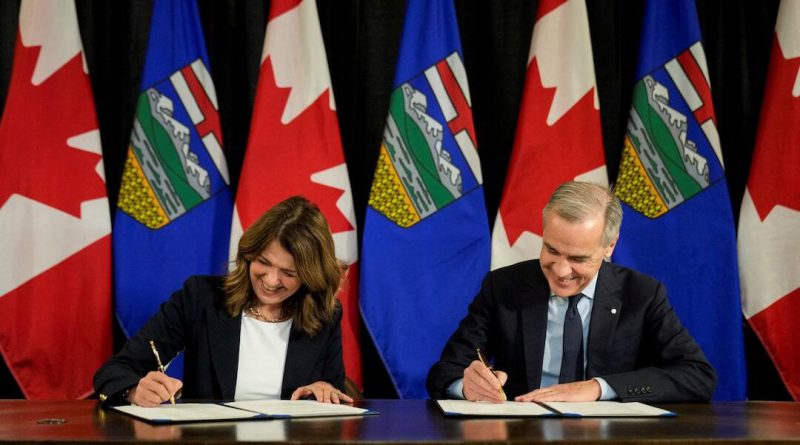Canada Drops Oil and Gas Emissions Cap in New Deal With Alberta
A major federal-provincial agreement reshapes Canada’s energy policy, removing the emissions cap while strengthening carbon pricing and opening the door for new export routes.
Canada has unveiled a new energy agreement between the federal government and Alberta, marking a significant shift in national climate and industry policy as both sides seek stability and investment in the sector.
The deal, signed in Calgary by Prime Minister Mark Carney and Alberta Premier Danielle Smith, removes the federal emissions cap on the oil and gas industry and repeals incoming clean electricity rules.
In exchange, Alberta has agreed to strengthen its provincial industrial carbon pricing system, and to support a major carbon capture and storage project aimed at lowering emissions from heavy industry.
The agreement comes at a time when Canada is looking to reinforce its economic position, as tense trade relations with the United States create new uncertainty for Canadian exports.
The government has emphasized that the country must diversify its energy markets, since nearly 90 percent of Canada’s oil exports currently flow to the United States.
Officials said the removal of the emissions cap was part of a broader strategy to enhance competitiveness, while still maintaining environmental commitments through carbon pricing and technological innovation.
Alberta, the nation’s largest oil-producing region, welcomed the shift as a relief for local producers, arguing that the cap had discouraged long-term investment and slowed expansion plans.
The province is now exploring the feasibility of a new crude pipeline to the northwest coast of British Columbia, a route that would allow Canadian oil to reach Asian buyers more directly.
However, no private company has yet committed to building such a pipeline, reflecting ongoing concerns about cost, regulations, and global energy market dynamics.
The federal government said it views additional export routes as vital for national economic resilience, especially given the fluctuating nature of global fuel demand and geopolitical pressures.
Carney stated that energy remains central to Canada’s economic strength, and that flexible but responsible policies are needed to adapt to the changing market landscape.
The new deal also aligns with Carney’s broader effort to ease certain environmental regulations, many of which had been introduced by the previous federal administration.
Supporters of the agreement say it reflects a realistic approach to balancing economic needs, while still advancing carbon-reduction goals through industry-led initiatives rather than federal caps.
Critics, however, warn that removing the emissions cap may slow progress toward national climate targets, and argue that voluntary measures alone may not produce the reductions needed in the coming decades.
The government responded by highlighting Alberta’s enhanced carbon pricing commitments, which it described as one of the strongest tools for driving emissions reductions across industry.
Alberta officials said the carbon capture and storage project will play a major role in future emissions planning, and could help position the province as a leader in low-carbon technologies if fully implemented.
The deal also includes collaboration on research, monitoring, and regulatory alignment, ensuring that both jurisdictions work together to support innovation in cleaner energy development.
Industry analysts say the agreement represents a pragmatic compromise, allowing for industry growth while ensuring that carbon policies remain in place to guide long-term transition.
The removal of the clean electricity regulations was also welcomed by Alberta, which argued that its grid structure differs significantly from other provinces and requires its own path.
As Canada continues to navigate economic and political challenges linked to international trade, the federal government sees cooperation with provinces as essential for maintaining stability.
The Trans Mountain pipeline, which underwent a major expansion last year, remains Canada’s only existing direct link to Asian energy markets after its capacity nearly tripled.
Officials say the new agreement creates space for future discussions about infrastructure, though any new project would need industry backing, regulatory approvals, and market certainty.
The coming months are expected to include further consultations with industry stakeholders, as Canada attempts to balance environmental goals with its role as a major global energy supplier.



